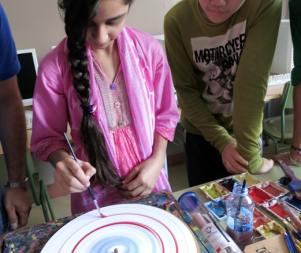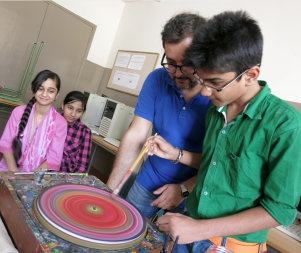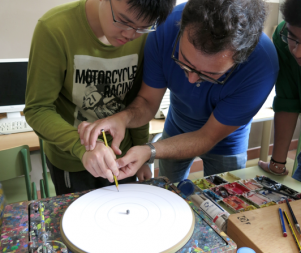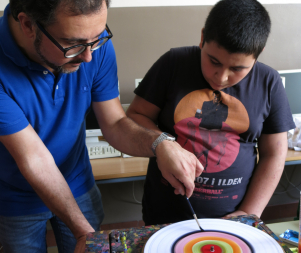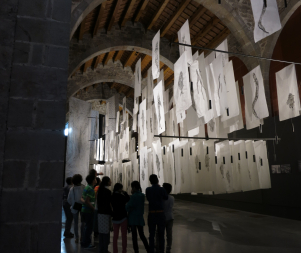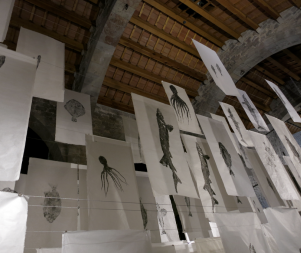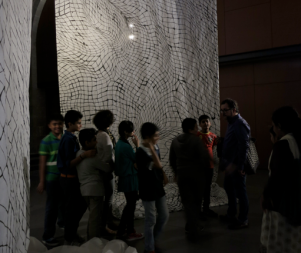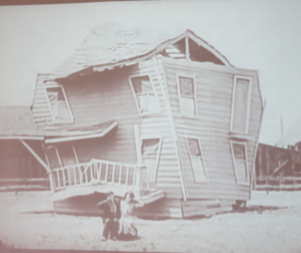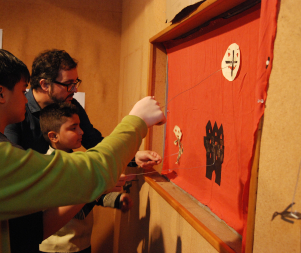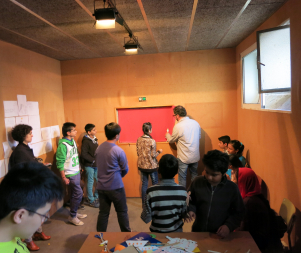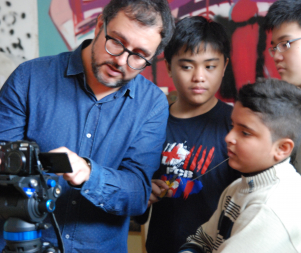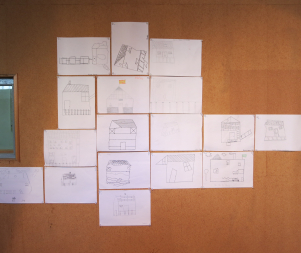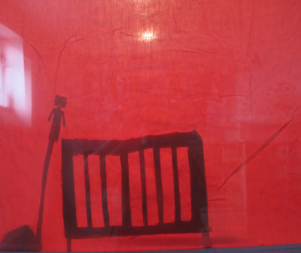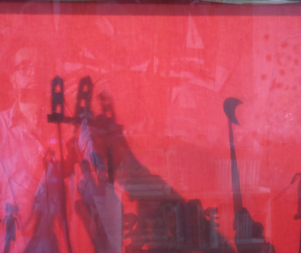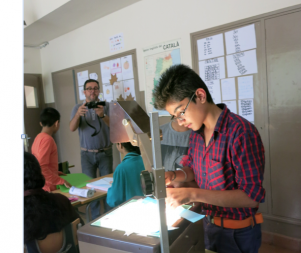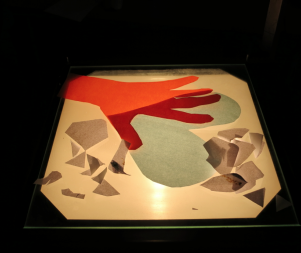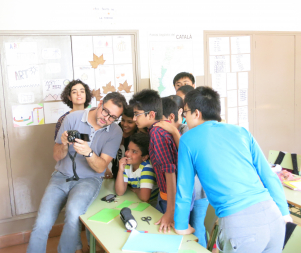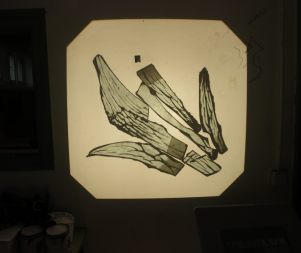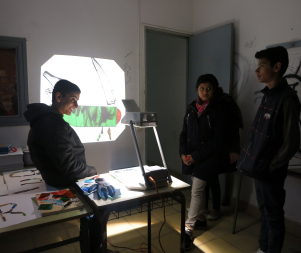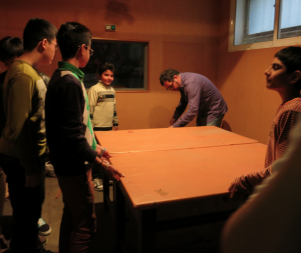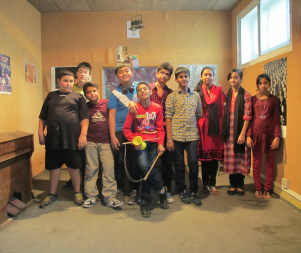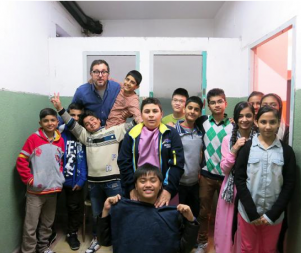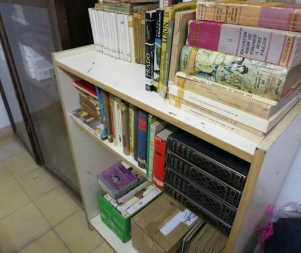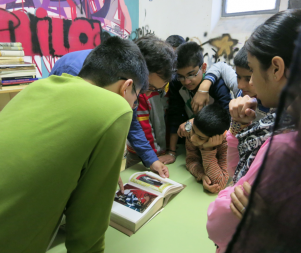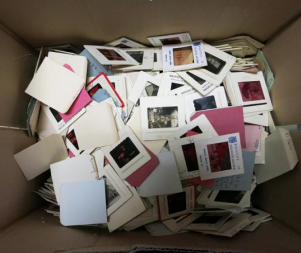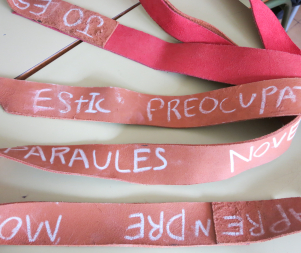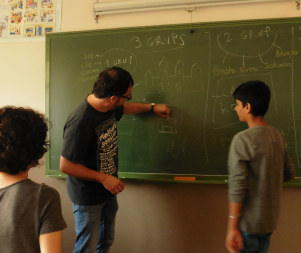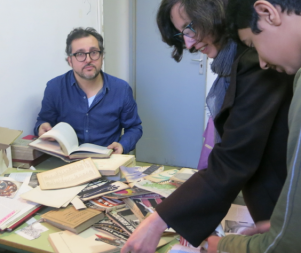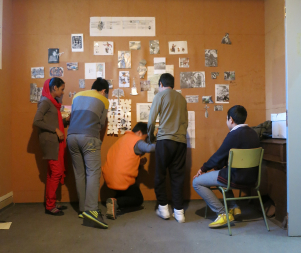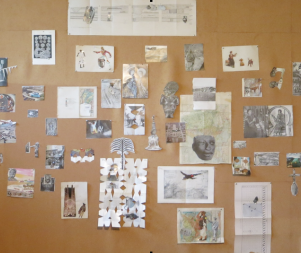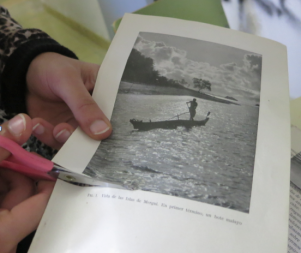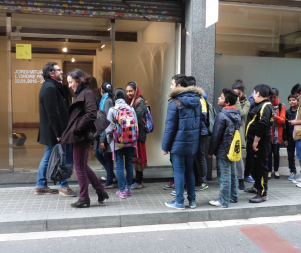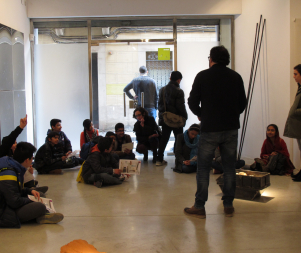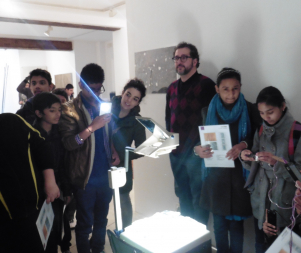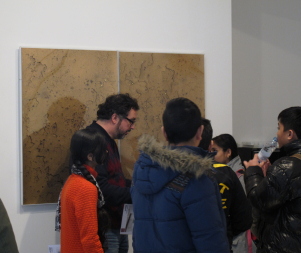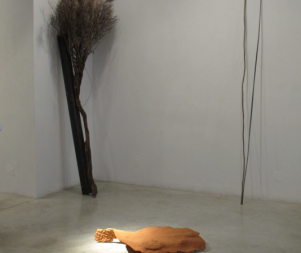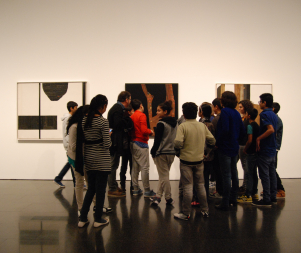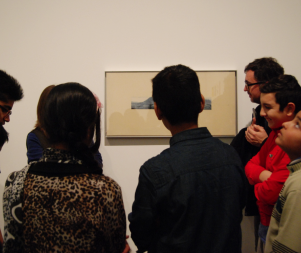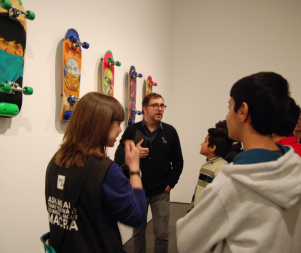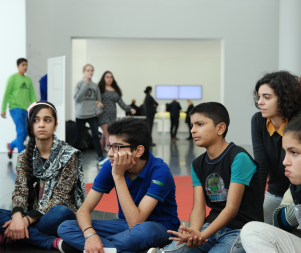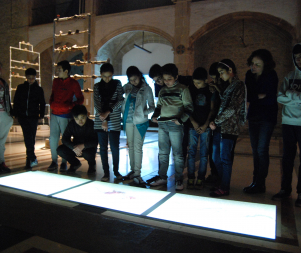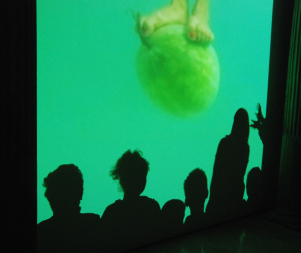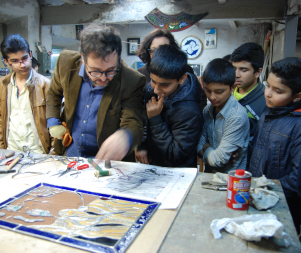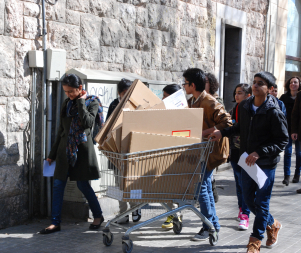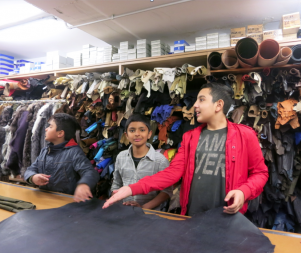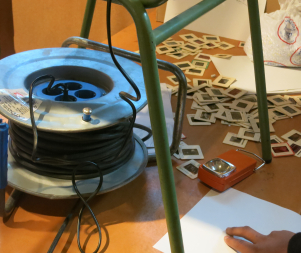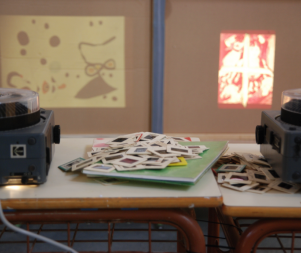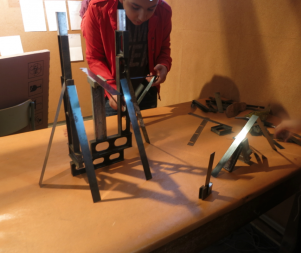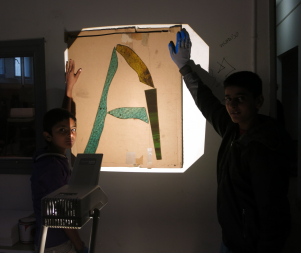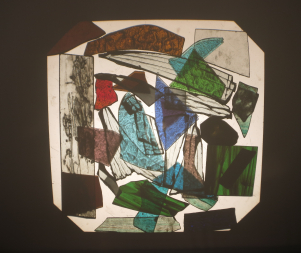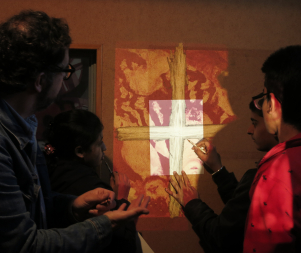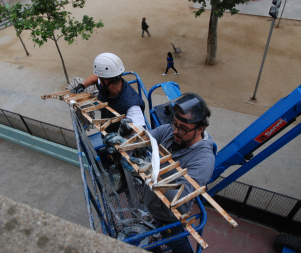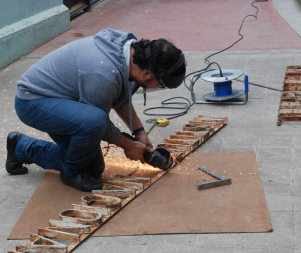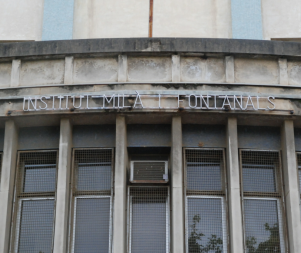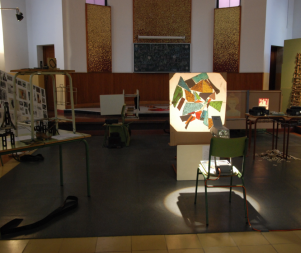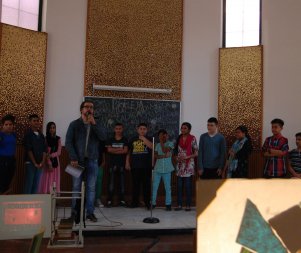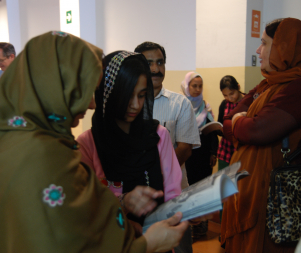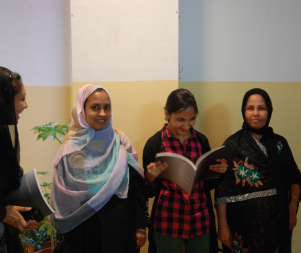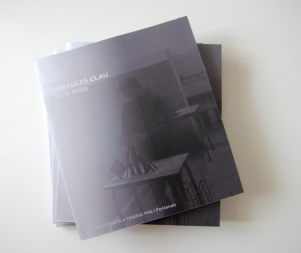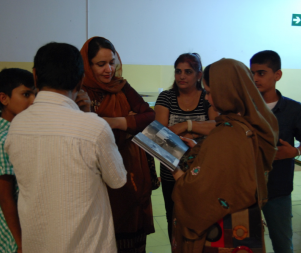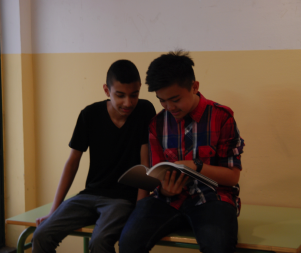- 14th EDITION 2022 / 2023
- 13th EDITION 2021 / 2022
- 12th EDITION 2020 / 2021
- 11th EDITION 2019 / 2020
- 10th EDITION 2018 / 2019
- 9th EDITION 2017 / 2018
- 8th EDITION 2016 / 2017
- 7th EDITION 2015 / 2016
- 6th EDITION 2014 / 2015
- 5th EDITION 2013 / 2014
- 4th EDITION 2012 / 2013
- 3rd EDITION 2011 / 2012
- 2nd EDITION 2010 / 2011
- 1st EDITION 2009 / 2010
Jordi Mitjà IN RESiDENCE at the School Milà i Fontanals
FIRST SESSION: THE RECORD PLAYER AND THE KEYWORDS
Working with a group of pupils from the reception class as part of the residency meant linking process with practice. That is why, at the first session, we organised a small painting workshop with a record player as a way of getting to know each other, not so much through talk as through action. It was decided at this first session that the project title would be Paraules clau [Keywords], placing the accent on the importance of language and language learning.
THE EXHIBITION GYOTAKU AT BARCELONA MARITIME MUSEUM
On the second day of the residency, we organised a visit to Barcelona Maritime Museum to see the exhibition Gyotaku. The purpose behind this trip was to see the form an art project could take and also to discover a cultural centre near the school.
The visit to Barcelona Maritime Museum served to introduce, from the start, certain key concepts, such as art project, exhibition, museum, process and so on. It also enabled the group to discover a site near their school and its collections and exhibitions.
BUSTER KEATON AND A SHORT FILM
With the aim of doing an initial activity that would help to bring the group together, we decided to make a short animated film using shadow theatre. Firstly, we watched a few Buster Keaton films, then began the creative process: writing the script, building the puppets and rehearsing the different parts in the work, entitled La princesa i el robot [The Princess and the Robot]. This first activity enables the group to discover a creative process in which various elements intervene, which has several different part and even an outside collaborator to do the final editing of the film.
A THIEF STEALS A TREASURE
Making a video
RECOVERING AN OVERHEAD PROJECTOR
After watching the Buster Keaton films, the discovery of a projector no longer in use at the school encourages the group to experiment with overhead projections of paper cutouts, using the stop-motion technique to animate them. The finally end up using different equipment to film their work, but the overhead projector becomes an important resource throughout the process.
A NEW SPACE: THE SCHOOL WORKSHOP
The work in the classroom causes doubts as to whether this is the right place to do this work. The classroom is not an appropriate space for a work-in-process that needs to remain assembled from one session to the next. For this reason, the group asks the school for permission to use the old Ràdio Milà studio, not in use at present, in the basement.
DISCOVERING NEW MATERIALS: WASTE MATERIALS AT THE SCHOOL
Installing the workshop in a space no longer in use represents an important discovery for the creative process, as there are in the old radio studio materials that have gradually been left here over time and illustrate the history of the school. This material, no longer wanted, includes slides, books, maps, posters and so on. Besides enabling the pupils to discover a world hitherto unknown to them, all this material also provides a starting point to generate the pieces that will form part of the final installation.
COLLAGES
Among the first works that the pupils create are a series of collages. These are made from the illustrations that the pupils find in the photography and art history books that the school no longer uses. The work enables them to discover names like Picasso and Bosch, artists that the pupils did not previously know about.
VISIT TO THE EXHIBITION L'ORDRE FERÉSTEC [THE WILD ORDER]
The fact that Jordi Mitjà has a solo exhibition at this gallery gives the group the chance to visit the site and discover his artistic processes and final works, as well as learning about ways of showing art. The pupils interview Jordi Mitjà, asking him all sorts of questions inspired by this visit, and the artist answers these questions.
The visit provides an excellent way of discovering the artist's work at first hand. The pupils also learn about the materials he uses and the type of work he engages in, discussing and asking him about everything they see. All this enables to group to discover that the elements he uses are, in the main, waste materials.
VISIT TO MACBA
The visit to see the MACBA collection is organised jointly with a tour of the temporary show devoted to Carol Rama, an artist who, at certain periods in her career, has worked with material recovered from an old bicycle factory. This gives the group an idea about the construction of the pieces that will form part of the final installation.
OUTINGS TO WORKSHOPS IN THE NEIGHBOURHOOD (RAVAL)
The next stage in the process therefore centres on the search for waste materials at craft workshops in the neighbourhood of the school. Contacts are established and visits are made to a glass workshop, a printer's workshop, a leather workshop and a shoemaker's. All these workshops give materials to the group, whilst also enabling the pupils to learn about the different crafts and trades. Before this, the group had watched some of the Minuts Lumière (Cinema en curs) short films made by their schoolmates about some of these workshops. The creators of the Minuts Lumière go to the reception class to tell them about their works.
http://blocsenresidencia.bcn.cat/milaifontanals1415/?p=413
In order to collect the diversity of materials needed to generate the work, a search is made at several workshops in the Raval neighbourhood. In a series of outings, the group visits a glazer's workshop (where they are given pieces of glass in different colours and textures), a printer's workshop (where they get pieces of lead, as well as cardboard and paper), a shoemaker (who gives them a last, or shoe form) and a leather workshop (which gives them strips of leather in different colours and thicknesses).
THE PIECES FOR THE INSTALLATION
The pupils now have materials to work with, and their own studio, and this generates a rather independent creative work dynamic in which the artist suggests the inspiration and the pupils produce different pieces. The idea gathers force of building an installation that, made from all these different elements, can nevertheless be seen as a whole, unified piece. The universe of materials from the school is combined with those obtained from workshops in the neighbourhood to generate a multiplicity of formal solutions.
THE SCHOOL SIGN
During the residency, the entire process is constructed around two main themes: keywords and waste material. At some point, Jordi Mitjà notices that the school sign reads “Instituto Nacional de Bachillerato Milà y Fontanals” and proposes an intervention on it, a meditation on the educational institutions itself which will also generate waste material: some letters, some words, which will form a new piece for the installation.
EXHIBITION. PRESENTATION AND VISITS TO SCHOOLMATES
The exhibition is presented in the chapel at Milà i Fontanals secondary school. All the pieces that form part of the installation are arranged in exhibition furniture also made by the pupils themselves from old school fittings and waste materials.
The pupils from the reception class and the artist Jordi Mitjà make the presentation to teachers, family members and other visitors. Over the days following this presentation, the reception class pupils arrange visitors for all primary and secondary pupils at the school.
THE PUBLICATION
The book Paraules clau [Keywords] is an attempt to bring the whole process together, a complete record and the entire experience represented by the residency. The publication is presented together with the art installation on the day of final inauguration.

